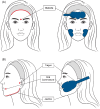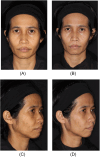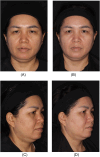The Efficacy and Safety of Synchronized Radiofrequency and High Intensity Facial Electrical Stimulation in Improving Facial Skin Laxity and Quality in Asians
- PMID: 39800907
- PMCID: PMC11844716
- DOI: 10.1002/lsm.23878
The Efficacy and Safety of Synchronized Radiofrequency and High Intensity Facial Electrical Stimulation in Improving Facial Skin Laxity and Quality in Asians
Abstract
Background: Noninvasive aesthetic procedures for facial rejuvenation are gaining popularity. Conventional treatments, such as radiofrequency (RF) and high-intensity focused ultrasound (HIFU), primarily improve skin quality but do not address the deeper musculoaponeurotic structures that affect facial laxity. A novel approach that delivers synchronized RF with high intensity facial electrical stimulation (HIFES) thought to target both the skin and underlying musculoaponeurotic framework to effectively enhance facial laxity has been investigated.
Objective: To assess the long-term efficacy and safety of combined synchronous RF and HIFES therapies in treating facial skin laxity among Asian subjects.
Methods: In this prospective, evaluator-blinded study, 15 participants aged 40-65 years with mild to moderate facial skin laxity were enrolled. Each underwent four weekly treatments using a synchronized RF and HIFES system using noninvasive electrode applicators on the forehead and cheeks. Objective assessments included forehead and cheek lifting measurements using a 3D photographic system, eyebrow lifting measurement using ImageJ software, skin texture and melanin levels using Antera 3D®, and skin elasticity using Cutometer® MPA 580. Additionally, patients provided self-assessments regarding their perceived level of improvement. Assessments were conducted at baseline, before the 3rd treatment, and at 1 month, 3 months, and 6 months after the last treatment.
Results: All participants completed the study. Significant improvements were observed in forehead and cheek lifting sustained at 6 months (p < 0.0001). A significant eyebrow lift of 1.39 mm was observed at 3 months (p = 0.0087), with a sustained lifting distance of 1.31 mm at 6 months (p = 0.0021). Skin firmness improved substantially (p < 0.0001), with R0 (skin firmness) increasing by 81.24% at 6 months. Skin texture improved notably in the crow's feet area (13.82% improvement at 3 months, p = 0.049). Melanin levels decreased significantly in the crow's feet and forehead regions. Treatment was well tolerated, with pain scores decreasing from 3.5 ± 1.8 to 1.6 ± 1.0 by the fourth session. No serious adverse events occurred.
Conclusions: Combined synchronous RF and HIFES therapy is a safe and effective Noninvasive method of improving facial skin laxity and quality in Asian subjects. Lasers Surg. Med. 00:00-00, 2024. © 2024 Wiley Periodicals LLC.
Keywords: facial lifting; high intensity facial electrical stimulation; monopolar radiofrequency; muscle stimulation; noninvasive; skin laxity; skin quality; synchronized radiofrequency.
© 2025 The Author(s). Lasers in Surgery and Medicine published by Wiley Periodicals LLC.
Conflict of interest statement
The authors declare no conflicts of interest.
Figures







Similar articles
-
Effect of Synchronized Radiofrequency and High-Intensity Facial Electrical Stimulation (HIFES) of the Upper Face.Aesthet Surg J. 2025 Apr 16;45(5):525-530. doi: 10.1093/asj/sjaf009. Aesthet Surg J. 2025. PMID: 39888339 Free PMC article.
-
Impact of Synchronized Radiofrequency and High-intensity Facial Electrical Stimulation on Facial Muscles and the Superficial Fascial System in the Midface.Aesthet Surg J. 2025 Mar 17;45(4):422-428. doi: 10.1093/asj/sjae252. Aesthet Surg J. 2025. PMID: 39749931
-
Mid Forehead Brow Lift.2023 Aug 21. In: StatPearls [Internet]. Treasure Island (FL): StatPearls Publishing; 2025 Jan–. 2023 Aug 21. In: StatPearls [Internet]. Treasure Island (FL): StatPearls Publishing; 2025 Jan–. PMID: 30571073 Free Books & Documents.
-
Holistic Approach for Noninvasive Facial Rejuvenation by Simultaneous Use of High Intensity Focused Electrical Stimulation and Synchronized Radiofrequency: A Review of Treatment Effects Underlined by Understanding of Facial Anatomy.Facial Plast Surg Clin North Am. 2023 Nov;31(4):547-555. doi: 10.1016/j.fsc.2023.06.006. Epub 2023 Aug 23. Facial Plast Surg Clin North Am. 2023. PMID: 37806688 Review.
-
Facial Rejuvenation and Contouring with Radiofrequency-Assisted Procedures in Asians.Clin Plast Surg. 2023 Jan;50(1):43-49. doi: 10.1016/j.cps.2022.08.009. Epub 2022 Oct 8. Clin Plast Surg. 2023. PMID: 36396260 Review.
References
-
- Martinez M. J., Dixit D., White M. W., and Rieder E. A., “Motivations for Seeking Cosmetic Enhancing Procedures of the Face: A Systematic Review,” Dermatologic Surgery 49 (2023): 278–282. - PubMed
-
- Coleman S. and Grover R., “The Anatomy of the Aging Face: Volume Loss and Changes in 3‐dimensional Topography,” Aesthetic Surgery Journal 26 (2006): S4–S9. - PubMed
-
- Cotofana S., Fratila A., Schenck T., Redka‐Swoboda W., Zilinsky I., and Pavicic T., “The Anatomy of the Aging Face: A Review,” Facial Plastic Surgery 32 (2016): 253–260. - PubMed
-
- Chilukuri S. and Lupton J., “Deep Heating” Noninvasive Skin Tightening Devices: Review of Effectiveness and Patient Satisfaction,” Journal of Drugs in Dermatology: JDD 16 (2017): 1262–1266. - PubMed
MeSH terms
LinkOut - more resources
Full Text Sources
Medical

